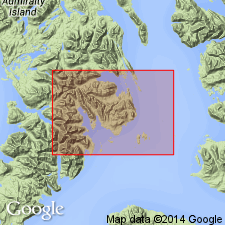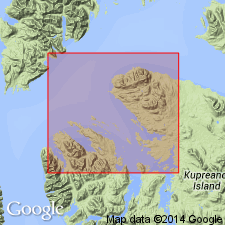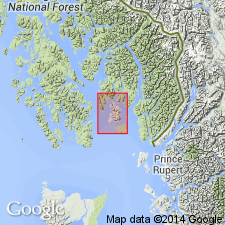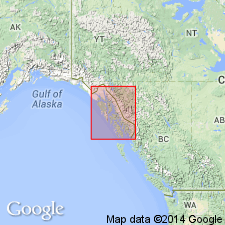
- Usage in publication:
-
- Hyd Formation*
- Modifications:
-
- Named
- Biostratigraphic dating
- Dominant lithology:
-
- Breccia
- Argillite
- Limestone
- Volcanics
- AAPG geologic province:
-
- Alaska Southeastern region
Summary:
Named for triangulation station Hyd on northeast shore of Pybus Bay, southeast shore of peninsula at triangulation station is type locality (argillite member). Dark-colored argillite, chert, graywacke, limestone, and altered volcanic rocks that crop out in thin, discontinuous belt from north shore Gambier Bay to southwest shore Pybus Bay. Consists of four members: basal breccia, limestone, argillite, and volcanic members which intertongue. Basal breccia has two facies, white chert where overlies Pybus Formation (30 ft thick) and red and green chert over Cannery Formation (350 ft thick). Breccia occurs throughout most of area. Limestone member of variable distribution and thickness up to 500 ft. Volcanic member, spilitic flows with pillow structures (up to 500 ft thick), common to north. Composite underlies Seymour Canal Formation. Contains ammonites, TROPITES (late Karnian) and MONOTIS SUBCIRCULARIS (middle or late Norian), identified by N. J. Silberling. Age is Late Triassic.
Source: GNU records (USGS DDS-6; Menlo GNULEX).

- Usage in publication:
-
- Hyd Group*
- Modifications:
-
- Revised
- Biostratigraphic dating
- Overview
- AAPG geologic province:
-
- Alaska Southeastern region
Summary:
In Keku Islets area (north Kuiu and Kupreanof Islands), Hyd Formation (Loney, 1964) raised to group rank; includes Burnt Island Conglomerate, Cornwallis Limestone, Hamilton Island Limestone, and Hound Island Volcanics (all new) which are broadly correlative with basal conglomerate, limestone, argillite, and volcanic members. Numerous fossils assigned by N.J. Silberling to six faunal units of Norian and Karnian age; some genera represented are MONOTIS, HALOBIA, MOJSISOVICSITES, TROPITES, DISCOTROPITES, and COROCERAS; groups include ammonites, clams, corals, and brachiopods. Age is Late Triassic. Group overlies Keku Volcanics, and disconformably overlies Pybus and Cannery Formations.; underlies Cretaceous sandstone and mudstone. Thickness of group at least 2500 ft.
Source: GNU records (USGS DDS-6; Menlo GNULEX).

- Usage in publication:
-
- Hyd Group*
- Modifications:
-
- Areal extent
- Geochronologic dating
- Revised
- AAPG geologic province:
-
- Alaska Southeastern region
Summary:
Hyd Group (Muffler, 1967) geographically extended south to include Puppets, Nehenta, and Chapin Peak Formations on Gravina Island and previously unnamed strata on Annette Island. Similarity of rock types (limestone, clastic sed. rocks, and basaltic to rhyolitic volcanic rocks), stratigraphic position, and age are basis for assignment to Hyd Group. Age tightly constrained by megafossils, conodonts, and U-Pb (zircon) apparent age of 225 +/-3 Ma (on Puppets Formation). Puppets Formation primarily rhyolitic rocks; most basaltic rocks are Chapin Formation; interbedded siltstones and limestones are Nehenta Formation. Rhyolite of Puppets Formation, similar to Keku Volcanics which underlies Hyd Group in Keku Islets area, is here included in the group [as shown on fig.9 rhyolite interbedded with rocks of Nehenta Formation thus included in group]. Rocks deposited during phase of uplift, erosion, and faulting based on interpreted latest Paleozoic-Triassic rifting event.
Source: GNU records (USGS DDS-6; Menlo GNULEX).

- Usage in publication:
-
- Hyd Group*
- Modifications:
-
- Areal extent
- AAPG geologic province:
-
- Alaska Southeastern region
Summary:
Hyd Group of Muffler (1967) geographically extended south to include the Puppets, Nehenta, and Chapin Peak Formation on Gravina Island and previously unnamed strata on Annette Island.
Source: GNU records (USGS DDS-6; Menlo GNULEX).
For more information, please contact Nancy Stamm, Geologic Names Committee Secretary.
Asterisk (*) indicates published by U.S. Geological Survey authors.
"No current usage" (†) implies that a name has been abandoned or has fallen into disuse. Former usage and, if known, replacement name given in parentheses ( ).
Slash (/) indicates name conflicts with nomenclatural guidelines (CSN, 1933; ACSN, 1961, 1970; NACSN, 1983, 2005, 2021). May be explained within brackets ([ ]).

